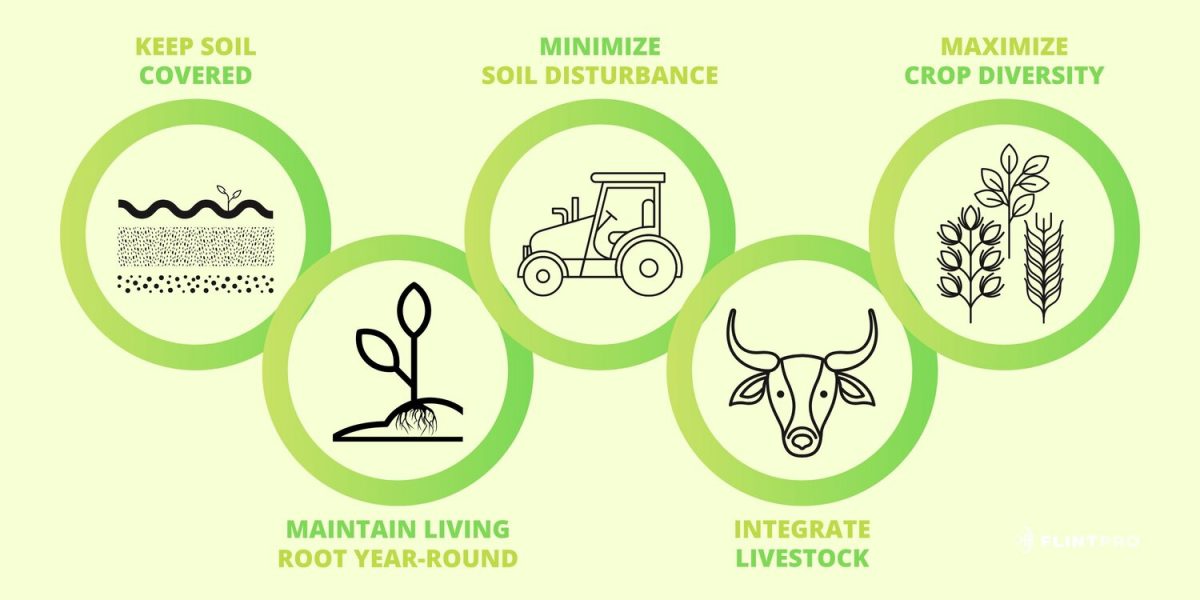From Green Revolution to Regenerative Agriculture – An Intersection of Innovation & Tradition

With the growing global demand for food and nutritional needs, agriculture is fast adopting to the situation in most parts of the world and is entering a transformative era. Although the green revolution has been successful in feeding a rapidly growing human population in the past decades, it has also contributed to depletion of the Earth’s soil and its biodiversity, and has contributed to climate change. The intensive practices are no longer sustainable. The world must move swiftly to transform agriculture through regenerative agricultural practices.
Regenerative agriculture is a food production system that nurtures and restores biodiversity by enhancing soil health, protecting climate and water resources, and improves farms’ productivity and profitability. It combines sustainable agricultural innovations with conventional farming systems focusing on reducing the use of water and other inputs, preventing land degradation and deforestation.
Objective of regenerative agriculture
Most regenerative agricultural practices such as inter-cropping, agroforestry, and integrated livestock farming are mostly associated with indigenous farmers who work with the land rather than against it. These regenerative farming practices mainly focus on producing enough nutritious food for the world’s population, helping with climate change mitigation by sequestering carbon in soil and reducing greenhouse gas emissions, restoration of endangered biodiversity and improving natural habitats, reducing deforestation., and enhancing farmer livelihoods.

1. Least soil disturbance
This principle involves the employing farming practices that minimize soil disturbance which have added benefits to the soil and the climate. The practice involves zero-till or use of reduced-tilling techniques to reduce its vulnerability to wind and water erosion, as well as degeneration of microbiome. Practicing minimum tillage enhances the soil’s ability to retain water, and improves crops performance and resilience during perennial droughts. Regenerative farming in this case involves planting seeds directly into the residue of the previous crop which contains more organic matter making it is less prone to erosion by wind or rainwater.

2. All Year-Round Farming
The practice involves growing of cover crops which provide all year-round plant coverage that prevents soil erosion and increases carbon inputs. Different crops are planted immediately after harvest, often alternating cash crops with cover crops protecting the top soil and increasing its moisture content through root penetration.

3. Diversifying crops in time and space
Practices such as crop rotation and inter-cropping, and agroforestry increases resilience, productivity, and diversity. Planting the same type of crops on the same field routinely degenerates the soil nutrients and encourages pests and weeds infestation. Regenerative agricultural practices such as rotating between nitrogen-fixing crops such as legumes and crops that highly use nitrogen like maize can greatly improve soil fertility.

4. Precision Farming
The application of inputs through data-enabled innovations based on observation, measurement and responding to inter and intra-field variability in crops leads to minimum and optimal amounts of production inputs. Precision agriculture involves use of digital tools such as soil sensors to map out a detailed understanding of soil nutrient content and tailor application of fertilizers and other crop protection products.

5. Mixed Farming
Practicing mixed farming whereby livestock and crops are grown on the same farm can have tremendous improvement on soil health, fertility and structure. The integration of livestock into crop production while using practices such as managed grazing can transform plant material into rich organic matter through manure production which can help prepare the land for the next planting season.
Benefits of Regenerative Agriculture
Regenerative agriculture when widely adopted and practiced has a wide of long-term benefits including:
- Increased yield & reduced deforestation.
- Improved biodiversity.
- Mitigated impact of extreme weather/climate.
- Enhanced farm profitability.
- Better nutrition and human health.
- Enhanced nutrient management, water retention, and less greenhouse gas emissions.
- Higher yields and increased food security.
What can be done to accelerate adoption and transition to Regenerative Agriculture?
The global population is estimated to reach 9.7 billion by mid-century while at the same time agriculture is currently facing increasing challenges from pests, diseases, effects of climate change and global warming, degraded land, vagaries of weather, among others. While modern farming has tried to feed the current global population of about 7.9 billion, there is still food insecurity and hunger that has plagued most parts of the developing world.
Food security is now a top priority in order to ensure the survival of the human race and to achieve these gains in the shortest time, more investment is needed to accelerate the widespread adoption of regenerative agricultural practices, something that will require heavy involvement of farmers, policymakers, and multinational agricultural companies.



